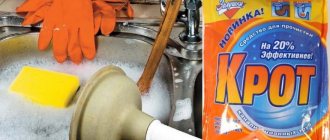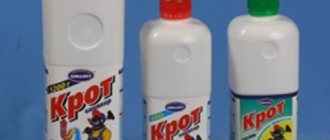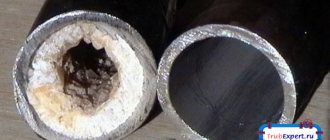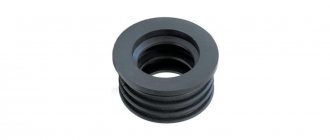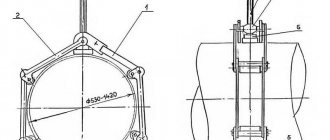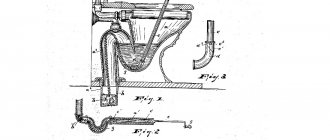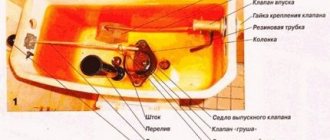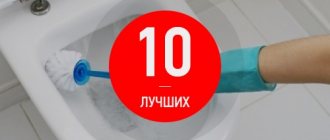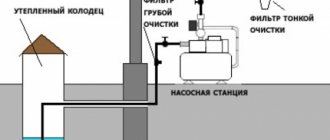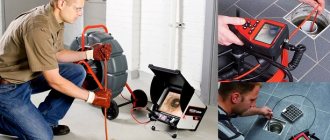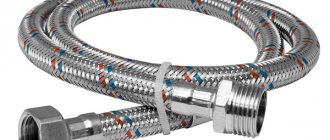Fighting blockages
If you have clogged pipes in your home, smile - you are not alone. The problem is not new; everyone faces it sooner or later. It may not be possible to deal with it right away, considering how many anti-clog remedies you can find in stores, but... it’s still possible! Especially if the “Mole” modestly knocked on your door.
This drug first appeared in the middle of the last century, but the demand for it does not subside. And how could it be otherwise if he still knows how to quickly and effectively deal with blockages and fatty deposits, as well as dirt on the inner surface of pipes.
Instructions
Instructions for use must be printed on the packaging of the product. It must be strictly followed. Do not increase the amount of the drug or the exposure time without permission. This will not improve efficiency, but may damage the inside of the pipes.
We recommend: 9 ways to use ammonia at home. Method 7 surprised even me
Application
If you purchased the product in the form of granules, then you need to proceed as follows:
- open the package;
- carefully pour the powder into the drain hole;
- pour the indicated amount of hot water there;
- let the drug work by waiting for the specified time;
- flush the system with plenty of water by simply opening the tap.
If a liquid or gel version of the product is purchased, then it is poured down the drain in the specified amount, but no water is added. Then they act in exactly the same way as in the case of using granules.
It is recommended to start cleaning the system by using more gentle products. If the effect is not obtained, then you should purchase a more concentrated version.
The Bio-Krot product should be used for the local sewage system as follows:
- dissolve the powder in warm water (to clean pipes up to 15 meters long, take 50 grams of the drug and 10 liters of water);
- pour the prepared liquid, distributing it evenly, into all drain holes of plumbing fixtures in the house - kitchen sink, bathtub, washbasins, toilet, etc.;
- wait the specified time, then flush the system with plenty of water.
If the blockage is serious, you will have to repeat the treatment several times until the problem is completely resolved.
For preventive cleaning of grease traps with a capacity of up to 100 liters, 100 grams of the Bio-Mole preparation are used. If a blockage has formed, then you need to increase the rate by 4 times. That is, to clean a grease trap with a volume of up to 1000 liters, you should take 400 grams of the product.
Types of means
It's no secret that blockages need to be dealt with using different methods. And in our case, the developer has provided for everything. So our “hero” can be found in three forms: gel, liquid, granular powder. Moreover, all these options cope equally successfully with blockages in pipes.
- Gel “Mole” is used for the prevention and removal of minor contaminants.
- The thick type is capable of reaching pipe bends and, accordingly, reaching the sewage there. The best effect is achieved with a minimum consumption. But if the blockage is severe, then it is better to use liquid - and you will gain speed, but you will also have to spend a lot of money.
- The version with granules is packaged in mini bags, intended for 1-2 single use, plus for prevention.
Types and forms of release of the drug "Mole"
Products are produced in several forms:
- liquid;
- gel;
- powder;
- granular.
The package may contain a single dose of the chemical or an amount for several uses. There are also containers with a volume of up to 10 liters, which are purchased primarily for treating plumbing units in hotels, fitness centers, laundries and other large establishments. In this case, the composition often contains fragrances and coloring agents, which does not affect the effectiveness, but does affect the cost of the product.
All varieties are easy to use, effective, and do not require special storage conditions.
Types of release of the drug "Mole".
Gel
The viscous consistency ensures a slow, gradual, more uniform distribution of cleaning components. The gel is economical, 1 liter is enough for 3-5 uses. It acts relatively gently, but eliminates any organic deposits and formed blockages.
Liquid
The solution quickly penetrates deep into the pipe and softens dirt plugs that impair drainage. Copes with old formations, eliminates unpleasant odors. Often used for preventive purposes.
Powder and granules
Dry varieties act more slowly than liquid ones. The reaction begins after they come into contact with water. A larger volume of running water is required to wash off the remaining substances used.
What are the differences between different types?
Types of Mole.
The varieties differ somewhat in composition and concentration of active ingredients; the names contain the corresponding notes:
- Master - removes uncomplicated blockages, more suitable for cleaning kitchen drains.
- Professional, Active, Concentrate - contain an increased dose of alkaline components.
- Tornado - quickly dissolves stubborn stains.
- Turbo - can be used to clean complex sewer units and toilets.
- Bio - contains bacterial cultures that process organic particles, used for treating wastewater, grease traps, drainage systems, dry closets, etc.
They are suitable for preventive and emergency cleaning and remove blockages of any complexity.
Purpose
As we have already understood, the task of the “Mole” product is to remove blockages in the pipe, especially in hard-to-reach places where it is impossible to get through or drive through the usual mechanical means. Of course, a lot of dirt accumulates in places where there are bends in the elbow, in the siphon, and in places where parts are joined near the rubber seals. Small and large debris likes to accumulate there due to the uneven surface. Over time, all this muck forms a small blockage, which prevents the liquid from flowing into the sewer without difficulty.
“Mole,” as we have already found out, contains active chemicals that soften accumulated dirt and dissolve it, after which the passage is cleared. Before doing this, you can wash off the residue with running water.
Remember that when interacting with contaminants, the product releases not the most pleasant hydrogen sulfide incense. Of course, there is an alternative to these joys - flavored “Mole”, which allows you to dissolve dirt without pinching your nose. However, this alternative is much more expensive than the usual one.
A small life hack
For better efficiency, before work it is better to heat the pipes and then run water for 10 minutes. This makes further cleaning easier.
Causes of clogged toilet
A properly functioning toilet is one of the basic conditions for a comfortable life. The toilet gets clogged because foreign objects are thoughtlessly thrown into it:
- unshredded food waste, bones,
- old rags and sponges,
- plastic bags,
- hygiene products,
- too much toilet paper, newspaper.
Pet owners can dispose of special litter for litter boxes down the drain. It firmly adheres to the pipes from the inside, reducing their permeability.
Frequent blockages are also possible if the toilet is not installed properly, or if there is no special valve, the function of which is to equalize the pressure in the sewer pipe.
Advantages of the "Mole" product
This drug has many advantages, otherwise it would not be in deserved demand. So…
Easy to use
A few manipulations are enough to get rid of the congestion for a long time (let’s not throw around the words “forever”). To do this, just take the gel or liquid version of the product and pour it down the drain. The contents will dissolve. A little patience, then open it, let running hot water in and wash off all that remains of the contamination.
Speed of action
If the contamination is small, then the product will cope in a few minutes. In difficult traffic jams, the “Mole” will sweat for about an hour and a half, but sooner or later it will do what is expected of it.
No pollution
When you try to “kill” dirt with mechanical force - a cable or a plunger, then all the impurities will appear on the surface of the bathtub or sink. And if you use “Mole”, then the remaining dirt does not come out, but is washed off with running water after the recommended time.
Availability
The pricing policy for this product is very democratic in relation to all layers. It is quite cheap and in many ways its use is more profitable. But the performance is no worse than expensive analogues.
Mechanical cleaning
Mechanical pipe cleaning is required to remove large objects that are difficult to dissolve. These could be rags, paper, leftover toilet filler, napkins, or foreign objects that accidentally fell into the drain. The classic way to fix such problems is to use a plunger.
Mechanical methods for cleaning pipes are generally more effective than chemical methods.
It is effective when the blockage has formed somewhere far away in the pipes. It is more convenient to use on flat surfaces; a bathtub is best suited for this. At the same time, other drain holes are covered with rags. The plunger is pressed tightly to the hole and the bath is filled with water. Then they sharply tear it off the surface. This creates a vacuum and negative pressure in the pipe, which pulls out foreign objects and breaks the plug.
The plunger creates hydraulic tension in the pipe, which destroys and pushes most of the contaminants forward.
However, using a plunger is not always effective, and it may not always be at hand. To do this, there are alternative mechanical ways to clean a toilet at home.
Plastic bottle
The principle of its operation is similar to a plunger, but it will be more effective in the toilet. Since it is not possible to install a plunger in this device. The width of a 1.5-liter bottle is quite suitable for installation in a toilet flush. To do this, the bottom is cut off and the lid is screwed on tightly. They insert it into the plumbing hole and move it back and forth. The air in the bottle begins to put pressure on the water and a water hammer is created, which breaks through the plug of contaminants. You need to repeat the procedure several times, then wash off the remaining items.
In case of emergency, a plastic bottle can replace a plunger.
Film plunger
The action of this item is also based on pressure difference. The advantage of the device is the absence of splashes and dirt in the bathroom. The device is filled with water and sealed with a plunger film. After this, pressure is applied to the film, which causes a water hammer to form and the plug in the pipe breaks through.
After eliminating the contamination, for preventive purposes it is good to pour one or two buckets of warm water with soda into the toilet.
For film, you can use purchased devices or regular wide tape. The latter is glued to the seat in several layers and secured tightly.
Cable and “doll”
For the cable, you can use any cable or stiff wire. The end is usually twisted into a spring, leaving a sharp tip. The cable is pushed into the pipe, rotating as it goes through bends and turns. It is more convenient for two people to work at once - one pushes the cable, and the other turns it. With some skill, one person can do it. After using the tip to find a foreign object, the cable begins to move back and forth, stirring the plug. In this way, you can either pierce it, or, by catching a foreign object, pull it back out.
An ordinary plumbing cable is an elastic, springy metal cable with a handle.
This method allows you to remove blockages from large objects in remote and difficult-to-reach places.
Instead of a spring, you can use a solid object - a “doll”. The doll is usually pushed separately into the pipe, after first disconnecting the plumbing. It is used to pierce the plug towards the riser.
How to use the "Mole" product. Instructions
Using household chemicals at home can pose risks to your health. Therefore, you should not neglect the instructions for this drug. First of all, you need to shake it without opening the container itself. Next, carefully pour the contents into the sink and try not to let the liquid get on your skin. It is best to wear gloves and carry out further manipulations in them. For sufficient effect, you can use 200-250 ml of the drug.
If we are dealing with the granular version of the “Mole”, then first we carefully pour the granules into the drain, then no less carefully and without splashing we fill them with hot water. Leave the product alone for 1.5 hours, after which we wash everything off with tap water. There is no trace of blockage or congestion.
Is it possible to use "Mole" with plastic pipes?
Today, most kitchens are equipped with a plastic plumbing system. The question is, how will “Mole” react to this material? We answer: Normal! In any case, the manufacturer does not express any warnings in this regard. If the pipe is made of high-quality plastic, then it will withstand any influence from certain liquids, even aggressive ones. Therefore, there is nothing to fear here. Chemicals will eliminate any complex contaminants and build-ups in the inside of the pipe without deforming it itself.
Cleaning the toilet yourself
Preliminary measures before cleaning the toilet
Before you start cleaning the sewer, it is necessary to inspect the visible part of the system in the bathroom and kitchen, since if water flows into one riser, the blockage may be common. If an obstruction occurs in a high-rise apartment, then perhaps a traffic jam has formed in a common building riser. And you won’t be able to eliminate it through your personal actions.
In an autonomous sewer system, toilet clogs most often occur in the internal elbow channel, at pipe joints at right angles, or due to cracking of a plastic pipe when it freezes. The latter option can occur if the sewer pipe runs above the freezing level of the soil, and it will have to be deepened.
To determine where traffic jams occur, you should have a good understanding of the design of the sewerage system installed in a private home.
If a general blockage has formed, then water will not flow out not only from the toilet, but also from the kitchen sink and the bathtub.
When living in an apartment building, in this case, you must contact the management company and submit an application for repair of the riser system.
In a private house, you will have to pierce the pipe laid from the house into the drainage pit (septic tank) yourself, or by calling specialists.
If the water does not flow well in only one of the branches of the system, then the plug must be looked for in a specific area. This localization simplifies the task somewhat.
If the blockage is not old, but formed literally today or yesterday, you need to act immediately in order to get rid of the uncomfortable situation as quickly as possible.
Methods for clearing urine stone from a toilet bowl are somewhat different from methods for removing other types of blockages, so they should be considered separately.
But no matter what cleaning method is chosen, it is necessary to carry out preparatory work to pump out standing water from the toilet. This process can be done using a plastic shampoo or detergent bottle by removing the cap.
Freeing the toilet from standing water using a plastic bottle.
By pressing the bottle, lower it with the hole into the water and gradually release the pressure - at this moment the liquid is taken into the container. After this, the water from the bottle is poured into a basin or bucket. The procedure is then repeated until the hole in the toilet is empty. The bottle in this case works like a syringe, only water is drawn into it much faster.
Traditional methods for eliminating a sudden traffic jam in the toilet
If the blockage occurred due to a small amount of contaminants getting into the pipes, which contributed to the formation of a plug, methods that have been tested in practice more than once will easily help you deal with eliminating the problem.
The first option is to use boiling water
The first way to get rid of a blockage is boiling water. However, this method and all others that use boiling water can be used if the toilet is connected to the riser with a plastic or metal pipe. If a corrugated pipe made of thin plastic is used to connect the toilet, then hot water should be used instead of boiling water.
- To clean, you will need a bucket of boiling water. It must be poured as quickly as possible not onto the walls of the toilet bowl, but into its opening, so that the boiling water immediately enters the knee canal.
- After pouring water, you must wait 30÷35 minutes.
A bucket of boiling water often helps to deal with a recently clogged toilet. But this method is not always acceptable!
- If the boiling water took effect and the water began to go away, then after it leaves, the procedure must be repeated. And so on until the normal function of the toilet is restored.
The second option is to use soda
The second cleaning option is to use baking soda. Washing soda ash is better suited for punching the gap, but baking soda is also possible. Some experienced housewives recommend adding regular salt - about half the amount of soda.
Washing soda ash is suitable for cleaning toilets and sewer pipes.
- Take a pack of soda (500 grams) and pour it into the toilet.
- Then the toilet is filled with a liter of boiling water. After this, a reaction will begin inside the knee, which can also clear it of the blockage. Soda is an active alkali that can dissolve many substances, so it is often used not only for cleaning plumbing fixtures, but also kitchen accessories.
The third option is a combination of soda and vinegar
The third cleaning method also includes soda ash, but in addition to it, vinegar and boiling water are used in this case.
- One and a half packs of soda (that is, 750 grams) are poured into the drain area.
- A glass or 0.5 liter of 9% vinegar is poured into it. When vinegar is poured in, a reaction should begin, accompanied by hissing and the formation of foam. This mixture must be left for 20÷25 minutes.
- After waiting this time, pour 2–3 liters of boiling water into the toilet and leave again for 15–20 minutes. After this, you can try rinsing with plain water.
Fourth option – mustard and hot water
In this case, powder mustard and hot water are used to clean the toilet (one small spoon of mustard powder is taken for two liters of water), and the composition is prepared as follows:
- 6÷8 liters of water are heated in a metal bucket or pan.
- Then add 3-4 tablespoons of mustard into it and mix.
- The solution is poured into the toilet and left for 15–20 minutes.
- After this, it is necessary to drain the water from the tank or from the filled bucket.
If necessary, the process must be repeated several more times.
Traditional methods of cleaning the toilet from urinary stone and limescale
Among the folk methods of cleaning surfaces from a layer of mineral deposits, there are several that are most often used at home. All of them will be effective if the substances used are poured or poured into a practically empty toilet - the level of the remaining water can be no more than 10÷15 mm from the bottom.
Citric acid in powder or liquid concentrated form dissolves mineral plaque well.
- Lemon acid . This substance can be used in crystallized or liquid form. For one stage of cleaning the toilet, you will need 200 grams of acid crystals or 300 grams of concentrated lemon juice, which is essentially the same acid. After this, the toilet must be left for 40-60 minutes, and it is better to perform this procedure at night, when the toilet will not be used. After this time, it is necessary to wash off the acid with water from the tank, and additionally rub the toilet hole with a brush. If plaque still remains, the procedure must be repeated.
Electrolyte can be purchased at an auto parts and accessories store.
- Electrolyte used for automobile batteries. This substance is also a very aggressive sulfuric acid. It will require 0.5 liters. The product is poured into the toilet and left for one and a half to two hours, depending on the thickness of the dirt, after which it is washed off. If necessary, the procedure is repeated.
“Coca-Cola” will help clean not only the toilet from plaque, but also the kettle or other utensils from scale.
- The popular drink Coca-Cola is an excellent remedy for mineral deposits in the toilet. This product will require 1.5 liters; it must be poured into a completely empty toilet and left until the reaction ends, that is, hissing, which can last up to two hours. Then you can rinse off the product. In addition to Coca-Cola, Fanta and Sprite are also used to clean mineral deposits.
It will be interesting to note that it is “Coca-Cola” that some cat owners use to clean cat litter trays, since it does not affect the animals’ sense of smell, unlike other detergents.
- Chlorine powder and solution . This well-known remedy does not always work, although it gives a strong reaction and an unpleasant odor. However, it is often used to remove a thin layer of plaque, as in this case it is most effective.
Bleach will perfectly whiten the enamel of the toilet bowl, but it cannot be used for colored earthenware, as light stains may form on them.
450÷500 grams of bleach are poured into the toilet in the evening and left until the morning. In the morning, the bowl is further cleaned with a brush, and the mixture is washed off with water.
An alternative to powder can be “Whiteness”, used for bleaching fabrics. One liter bottle of solution is required for one cleaning. The inconvenience of using this product is the duration of exposure, as well as a persistent unpleasant odor.
- Oxalic acid is a special cleaning agent for plumbing accessories that can be purchased at hardware stores. The acid is sold in powder form and copes well with difficult-to-clean deposits of urinary and fecal stones, as well as old rust on enamel surfaces.
Oxalic acid is an effective and inexpensive cleaning agent for toilets, bathtubs and sinks.
Using this tool is easy. You just need to pour it out of the bag into the toilet drain hole and leave it for one to two hours. Then, the resulting mixture is washed off and cleaned with a brush.
- Soda, vinegar and iodine. This composition is good to use not only for cleaning the drain hole, but also for removing mineral deposits from the toilet bowl rim. To prepare the mixture, one glass of 9% vinegar is heated, a small spoon of iodine and a large spoon of soda are added to it. Everything is mixed well and poured into the toilet, and then distributed over the rim with a brush. This product will take 8-12 hours to work, meaning it is best left on surfaces overnight. In the morning, the mixture is washed off with clean water.
Video: Vinegar as a means of removing urinary and limestone deposits in toilets
Household chemicals for removing blockages
Compositions for clearing formed traffic jams
To break through blockages formed in the sewer, you can also use ready-made chemical compositions. They are presented in a wide range in hardware stores and supermarkets.
Almost everyone is familiar with such products as “Mr. Muscle”, “Tiret”, “Mole”, “Sanfor”, “Domestes”, “Floop”. The compositions are sold in solutions, gels and granules, so you can choose the most convenient form for use.
Chemical compositions for cleaning the toilet from blockages.
Detailed instructions for using such chemicals are always located on the packaging. And before you start using them, you must familiarize yourself with it.
It is not difficult to use ready-made cleaning compositions, especially since almost all bottles are equipped with a convenient spout, allowing you to easily deliver the gel or solution under the rim of the toilet bowl.
The product is poured or poured into the toilet drain hole in the doses specified by the manufacturer in the instructions. After which the toilet is left for a certain period, since the composition needs time to act. The contents are then flushed down the drain.
Chemicals for cleaning toilet bowls from urinary stones
All of the manufacturers listed above produce several types of compositions with different purposes, including specifically for removing mineral deposits. However, in addition to them, other effective formulations are presented in stores:
| Appearance of packaging | Brief characteristics of the cleaning product |
| "Bon" is a highly effective liquid mineral plaque remover made by a Czech manufacturer. It can be used not only for the toilet, but also for the sink and bathtub. In addition, the product dissolves lime deposits on the surfaces of metal products. "Bon" is also used to clean any plumbing accessories from rust and grease. The solution is non-toxic and has a pleasant aroma. It is convenient to apply it to both visible and hidden surfaces, since the bottle is equipped with a spray nozzle. Bottle volume - 500 ml. | |
| "Eurogarant" is a universal sanitary gel made in Russia. It is designed to dissolve and remove urinary stone, lime deposits in the bathtub and sink from the internal surfaces of the toilet bowl, as well as to clean tiles. The volume of the bottle is one liter. | |
| “Cillit Bang Anti-plaque + Shine” “Ocean Fresh” is a Russian-made antiseptic cleaning product that can rid the surfaces and internal parts of plumbing fixtures of limescale, urinary stone, rust and other contaminants. The effect of this product begins within one minute after its application. Moreover, its effect is equivalent both under water and in its absence. The presence of a convenient spout on the bottle makes it easy to apply the solution under the rim of the toilet bowl. “Cillit Bang” removes not only dirt, but also unpleasant odors typical of the toilet and stagnant water in sink and bathtub drains. To achieve maximum results, just wait 30 minutes after applying the product. Then you need to clean the toilet with a brush and flush the water. The Cillit Bang is suitable for cleaning enamel toilets and sinks, but cannot be used on stainless steel items. The volume of the plastic bottle is 750 ml. | |
| "Shumanit" is an Israeli product made in the form of a concentrated gel. It is designed to remove limescale and urinary stone, rust and serious dirt, giving the toilet a long-lasting shine and freshness. "Shumanit" disinfects surfaces, preventing the spread of germs. The effectiveness of the product does not decrease even under water, so when using it you do not have to completely empty the toilet drain hole of it. A plastic bottle with a volume of 650 ml is convenient to use due to the presence of a spout. | |
| Gel "ORO-fresh" is a German product for effectively and quickly cleaning the toilet bowl from urolithiasis and lime deposits, grease deposits and other contaminants. The gel easily dissolves plaque accumulated on the walls without leaving any streaks or other marks. The product is antibacterial and gives surfaces a fresh lemon scent. The bottle, which has a volume of 750 ml, is also comfortable to use, as it has an easy-to-use shape. |
It should be noted that if the urinary stone deposit is quite thick, then it is unlikely to be dealt with with a one-time cleaning. Therefore, to achieve the desired result, the process will have to be carried out several times.
Strong chemicals must be used with a certain degree of caution, in accordance with the manufacturer's instructions. Otherwise, the possibility of damage to both metal and plastic pipes cannot be ruled out. It is not recommended to use several drugs at the same time, as an unexpected chemical reaction may occur with unpredictable consequences.
Mechanical methods for removing plugs
Another direction in cleaning clogged sewers is mechanical methods, which often solve the problem without the use of chemicals or improvised means. However, it is worth immediately noting that it is mechanically impossible to remove blockages caused by a thick coating of urinary stone or rust - a set of measures is used to clear them.
The first method is cleaning with a plunger
This is a well-known and perhaps the most popular method, which often provides good results. For example, in cases where a plug has formed in a sewer pipe or toilet elbow due to coffee or tea grounds constantly being poured into it.
A plunger that has a nozzle with a cut cone at the end, with a cut diameter of 100 mm, works more effectively.
Most often, a plunger easily copes with breaking through a clogged pipe, if the plug is not old.
When cleaning a drain with a plunger, the toilet bowl must be filled with water. Then the plunger is installed in its drain hole and several pumping presses are made. After this, the device is sharply pulled out of the hole. This procedure is repeated several times if necessary. If the blockage was minor and had not yet “solidified”, after removing the nozzle from the drain, the water will actively drain into the pipe.
The second method is a homemade plunger from a plastic bottle
If there is no plunger in the house, and the toilet needs to be cleaned urgently, then a regular one and a half liter plastic bottle will do instead. To turn a bottle into something like a plunger, the bottom is cut off, but the rounding around the hole must remain, that is, only its lowest hard part is removed.
Cleaning drains using a regular plastic bottle.
The process is carried out according to the same principle as using a plunger with a rubber nozzle. The cut side of the bottle is lowered into the drain hole and pressed well against its walls. Then several pressing movements are made, after which the “tool” is sharply removed from the drain.
The third method is to use a plumbing cable
Another device that will get rid of the blockage 100% if it has formed in the toilet elbow or in the pipe to the common riser is a plumbing cable. The device is a rigid spring with a handle attached to one side. The cable can have different lengths, depending on the conditions in which it will be used. For autonomous sewerage, a cable 15,000 mm long is sometimes required.
One of the most effective solutions for mechanically cleaning toilet clogs is a plumbing cable.
Cleaning with a metal cable is carried out due to its flexibility and ability to move into the sewer pipe to a considerable depth through curved sections.
Using a cable with a spiral attachment at the end, you can try to pull out foreign objects that, for example, a child threw into the toilet
The work is carried out in the following order:
- The end of the cable is lowered into the toilet drain until it hits the resulting plug.
- Then you need to start slowly rotating the handle, pushing the cable inside the pipe. As it moves forward, the cable will move the blockage.
- The final step of this procedure is to flush the pipes with hot water with the addition of technical soda.
If there is no cable, then you can try cleaning it using a rigid but flexible cable, the main thing is that it has the required length and diameter. It is pushed into the sewer pipe through the toilet, turning it periodically. Thanks to such actions, you can destroy the plug blocking the pipe, or push through an object stuck in the pipe or elbow.
Cleaning with a cable should be carried out with special care if the toilet is connected to the sewer pipe by thin-walled corrugation. It doesn't take much effort to break through such a wall.
Check out the types of grease traps for sewage and their installation from our new article on our portal.
The fourth method is a film plunger
In South Korea, a special high-strength film-plunger “Pongtu” has been developed, produced and supplied to the Russian market, which can be easily used for any size toilet.
Clearing a clogged toilet using a special film plunger. The process occurs without unpleasant splashing of water on the sides
The film is glued to the top of a toilet bowl filled with water, and then pressure is applied intensely and rhythmically with both hands. Thus, this device operates on the principle of a plunger, but there are no splashes flying in different directions or even in the face, which often happens during normal cleaning.
If you come across such a set of two films on sale, it would be a good idea to purchase it for an emergency.
The kit comes with two disposable films and is a good idea to have on hand in case of unexpected clogs.
Video: An original effective method for cleaning a toilet - the Pongtu plunger film
An alternative to the South Korean development could be domestic wide adhesive tape, which can also serve as a plunger. It is used as follows:
- The surface of the bowl is wiped dry so that the tape adheres well to the enamel.
- Then, numerous strips of adhesive tape are glued on top, covering the bowl in several layers and firmly connecting the adhesive tape to each other. The edges of the film are glued to the side surfaces of the bowl, after which, for greater reliability, they are secured with a common strip. The tape must be well stretched so that the end result is a kind of membrane.
- Then, several intense pressures are applied to the film, as a result of which the plug should be eliminated.
- At the end of the work, the tape is removed from the surface of the toilet.
Precaution
To avoid skin burns that can be caused by chemicals, it is better to wear protective gloves and wear a mask on your face to protect yourself from sodium hydroxide.
If, alas, contact does occur with the liquid, then, without wasting a second, you need to devote all your efforts to reducing the aggressive effect of the product on the skin and mucous membranes. Namely: rinse the area where the product comes into contact with plenty of water; If the drug gets into the eye, you should immediately consult a doctor.
If the “Mole” got inside, as in the recent well-known case, then it is very life-threatening. To relieve gastrointestinal damage, drink 2 liters of water and immediately contact an ambulance service.
Of course, it is very important that this drug should be kept out of the reach of children in order to avoid burns and poisoning.
If all precautions are taken, then unpleasant consequences will pass by. But one way or another, today “Mole” is one of the best assistants in the fight against complex contaminants in the pipe and for carrying out high-quality prevention of the sewer system.
